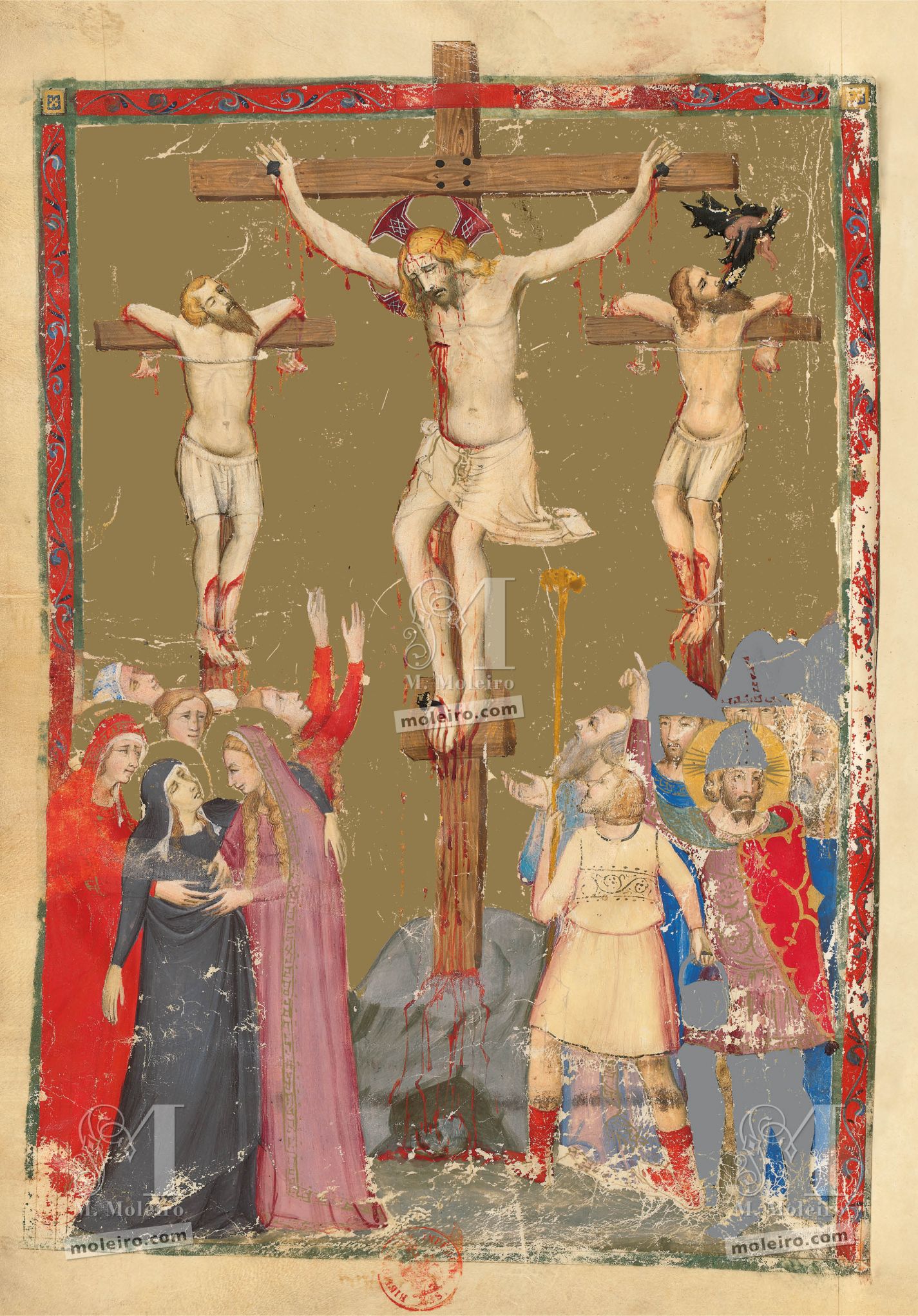This illumination, with no biblical text in the margin, is like a devotional painting. The style is monumental: the gold leaf floods the page with the timeless light of altarpieces. The vertical upright of Christ’s huge cross extends up and beyond the blank, red sign which blurs into the decorative frame. Christ bleeds profusely from the wounds inflicted by the nails and the spear that pierced his side. The blood running down his arms, legs and feet forms a pool at the bottom of the Calvary. A human skull can be made out in a crevice in the rock upon which the cross stands. This picture of Golgotha (Hebrew for “the place of the skull”) is highly symbolic for this is where the remains of the first man are brought back to life by the blood of salvation in a promise of resurrection for all humanity.
Christ’s feet are supported by a wedge to prevent his hands being torn from the cross by his weight. A perizonium knotted on one side hides his nudity. His face with closed eyes is delicately sculpted by delicate shading that outlines his short beard and gives him a grey complexion. The relief of his torso is masterfully modelled. The Italian art historian Ferdinando Bologna compared the crucified Christ on f. 177v to a Crucifixion painted in Giotto’s Naples atelier in c. 1333 (private collection). This comparison demonstrates the great influence Giotto’s style still had in Naples twenty years after the death of the master, who lived in the Angevin capital from 1329 to 1333.
The different expressions of the two groups at the foot of the cross reveal that Jesus has just died. The women are gathered on the left. Our Lady is deathly pale and depicted for once as a middle-aged woman. Dressed all in black in mourning, she swoons in grief in the arms of the two Marys: the sister of her mother, Mary, the wife of Cleopas, and Mary of Magdala (John 19: 25). One holds her under her arms and the other grasps her cloak. The four women weeping behind them include a tearful young woman reaching out to the Messiah and probably Salome, the mother of the apostles James and John. The men are on the right. A man with a sponge mounted on a reed administers vinegar to Christ from the small bucketful he holds. The old man behind him looks at Jesus and gestures as if to say he has died. This man may be the Jew Joseph of Arimathea, a member of the Sanhedrin who secretly converted to the Lord’s teachings. At the same time, an armoured Roman guard with a nimbus and a shield points his index finger at the Messiah whilst looking at the reader. This is the centurion touched by grace who cries out in the Gospels, “Truly this was the son of God” (Matt. 27: 54). Upon hearing these words, the soldiers standing behind him were suddenly seized with fear.
The two thieves crucified with Jesus flank Christ in the background. They are tied by the arms to two tau crosses, their elbows have been broken, their wrists and ankles tied, and their shins have just been broken. A black bat, symbolising the Devil, flies off with the evil thief’s soul, depicted as a brownish, new-born babe, in its claws.
On the whole, the style of this miniature is similar to painter A’s but the faces of Christ, Longinus, the two thieves and Mary were apparently entrusted to a more skilful, sensitive hand.
